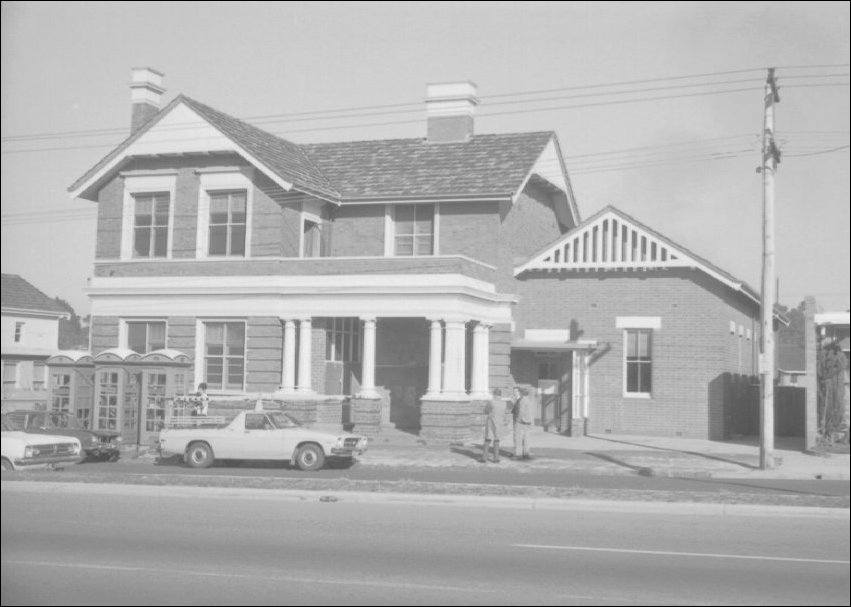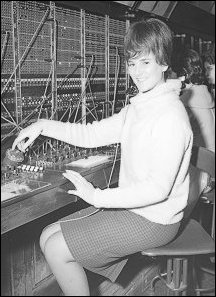The Post Office at Cheltenham

Cheltenham Post Office and Telephone Exchange c1972. Courtesy Eric Longmuir.
By 1857 the population of Cheltenham numbered about 150 persons, and on the August 1 of that year, a small post office was established in the township under the management of John Hitchen, which he conducted in conjunction with his boot and shoe store. It was agreed he should receive $40 per annum for his postal duties. However Mr Hitchen only operated the post office for three months, for on February 6, 1857, it was transferred to Robert Trail (or Traill), who managed a general store. The Trail family were enterprising, hard-working people, who kept the store open until ten p.m., and whose small emporium stocked just about everything from men and boys clothing, dresses and underclothing for the fairer sex, patent medicines, groceries, salted fish, horse feed, hardware, green groceries, etc.
An 1862 mail list shows that mail was conveyed - “To and from St Kilda Railway Station and Cheltenham, by way of Elsternwick, East Brighton, and South Brighton, six days a week, by coach.” As Brighton was already connected to Melbourne by rail, it seems likely that the coach service passed through a number of settlements not conveniently situated to receive their mail by rail. The 1862 list also shows that a mail service operated between Cheltenham and Tootgarook, by way of Frankston, Schnapper Point, and Dromana, which operated twice a week. During 1860, a total of 7,200 postal articles were handled at the Cheltenham Post Office.
On October 1, 1861, the management of the post office passed to Mrs Janet Trail. By 1865 there was a second mail service operating between Melbourne and Cheltenham. This mail was carried by coach that travelled by way of Cheltenham, Mordialloc, Frankston and Mornington, six times a week.
The Victorian Gazetteer for 1865 gives an interesting description of the township at that time. Cheltenham is described as - “A postal township in the parish of Moorabbin and electoral district of S. Bourke. It is situated 3 ½ miles N. of Mordialloc, on the coast of Port Phillip at the head of Mordialloc Bay, Brighton being 5 miles N. With both places there is communication by the coach which runs from Melbourne to Mornington daily. There is also an omnibus (horsedrawn) to Brighton to meet the trains to and from Melbourne, which is distant 12 miles N.W. Cheltenham has a Masonic Institute and a Post and Money Order Office. The hotels are the ‘Cheltenham’ and ‘Armagh’. There is a carrier who plies with a spring van to and from Melbourne, twice a week. The surrounding country is undulating, lightly grassed and timbered, and much cultivated by farmers and market gardeners. The population numbers about 250 persons.
On February 1, 1868, Post Office Savings Bank facilities were provided at Cheltenham Post Office. Five years later, Mrs Trail was succeeded as Postmistress at Cheltenham by her daughter, Margaret Trail. Margaret managed the post office for two years - from 1873 to 1875, when the office was transferred to Thomas Chandler, who operated a boot and shoe store. Altogether, the Trail family had conducted the post office for a period of eighteen years.
The Victorian Gazetteer for 1879 shows further development within the area. It mentions - “There are two tomato sauce manufactories in the place, which is an agricultural one, takes up for market gardens principally. Omnibuses run twice daily between Mordialloc and Brighton Railway Station. There is no public conveyance to Dandenong, and with Melbourne (12 miles North), the communication is by rail from Brighton. Cheltenham has a Mechanics Institute with a circulating library. Population (including Beaumaris and Kingston) is about 1,000. There are Church of England, Wesleyan, Presbyterian and Disciples of Christ Churches in the township, and a reserve for a part very prettily situated W. of the township, from which may be obtained fine views of the Bay and surrounding country. A police court is held at Cheltenham every alternate Friday. The nearest telegraph is Mordialloc.”
On December 19, 1881, the extension of the railway line from Caulfield to Mordialloc was opened to traffic, providing residents of Cheltenham with a direct rail link with Melbourne. The Australian Handbook for 1882, states in its entry on Cheltenham that - “A coach passes through daily, fare 1/6d. There is also omnibus communication with the trains at Brighton, faire - bus and train - 1/9d. The land is of a very sandy nature, well suited for market gardens. The hotels in the village are the ‘Exchange’, ‘Cheltenham’ and ‘Royal Oak’ (previously the ‘Armagh’), with several private boarding houses near the beach, 1 ½ miles W. State schools at Beaumaris (No. 84), at Kingston (No. 938). Churches: Episcopal, Presbyterian, Wesleyan and Disciples of Christ, and two stores. It was once a favourite meeting of the Melbourne huntsmen, but settlement has driven the kangaroos away. Population 697, or including Beaumaris on the W. and Kingston on the E., about 1,000.” It should be remembered that material for the 1882 Handbook would have been prepared in 1881, before the railway station at Cheltenham had opened, hence the reference to a mail coach, and an omnibus link with Brighton.
By 1883, the rail fare from Cheltenham to Melbourne was 1/5d. First Class, or 11d. Second Class. During 1885, a telegraph office opened for public use at the railway station.
The year 1891 saw the raising of the post office from non-official to official status, when the office was transferred from a private shop to new premises owned by the Postmaster-General’s Department. The new building, located on the Point Nepean Road, cost $3,244 to erect. Isabella McColl was appointed as Postmistress in charge of the new office, and she was given a staff of four to assist her. The Victorian Municipal Directory for 1891 mentions a horse tram that operated regularly between Cheltenham and Sandringham. Further development is recorded in the Australian Handbook for 1895, which records rail fares from Cheltenham to Melbourne as 1/1½d. and 10½d. It also mentions a Protestant Hall, used for large public gatherings, a convalescent home for men, a ‘Home of Mercy’, and a ‘Rescued Children’s Home’. The population was given as - “310, or including Beaumaris and Heatherton, about 1,500. A horse tram runs at intervals to Sandringham - fare 6d. Local newspaper - Cheltenham Leader.

Rhonda Grahame sits at the old manual switch board at Chelsea Exchange 1965. From Leader Collection.
An important milestone in communication was reached in 1899, when Cheltenham residents were provided with a manual telephone exchange. Twenty-four subscribers were connected that year. The exchange was located at the post office. Among the early subscribers were - No 4 Mrs. Matthew Lang, Rickard’s Point, Sandringham; No 6 Beaumaris Hotel; No 8 Miss Watt, Nurse, Ingleside, Charman Road; No 10 Bridge Hotel, Mordialloc; No 11 E Caudwell & Co., Timber Merchants, Mentone; No 12 Hill’s Mordialloc Hotel; No 16 Cheltenham Hotel; and No 23 Exchange Hotel.
During 1902, Alice Blanche Fyans succeeded Isabella McColl as postmistress at Cheltenham. Then followed - Mrs Mary Madden, in 1904; Harriet Barclay, in 1916; George E Scott, in 1926; William Nicholls, in 1930; George D. Spicer, in 1935; Archibald A Will, in 1949; Sydney D Cooper in 1963; Thomas R Wickham in 1964; and Laurie De Longville in June 1973.
A mail notice in the Government Gazette for August 5, 1905, shows that Mr G Cochrane of Cheltenham was appointed local mail contractor for a period of three years. The service is described as - “One delivery to be effected daily by two mounted letter-carriers employed simultaneously, the last letter to be delivered before noon.” Mode of conveyance was on horseback.
By 1909, the Cheltenham manual telephone exchange was providing a day and night service. At the commencement of that year the exchange served exactly one hundred subscribers.
Between 1908 and 1911, W Taylor of Cheltenham held the contract for local mail deliveries. Between 1914 and 1917 it was managed by John Murphy, also of Cheltenham, and between 1920 and 1923, the round was divided between Horace S Jewell and George Monk.
By 1934, the number of subscribers served by the Cheltenham exchange had increased to 663. During November, 1945, land at the rear of the post office was acquired as the site for an automatic exchange. This land had a frontage of approximately 44 metres to Charman Road. The new exchange, and its associated equipment was completed in 1951, during which year it was cut into service. There were approximately 1,700 subscribers at that time. In 1964 - just thirteen years later, the number of subscribers had increased to 6,800 and by November 1974, it had reached the 12,000 mark.
To keep pace with the needs of this rapidly expanding area, the contract for the erection of a new post office, facing into Charman Road, was awarded to T W Morris & Son Pty Ltd of Mordialloc, on June 14, 1973. Contract price was $185,684. The part two storey building is of reinforced concrete construction, faced by red brick. It provides an overall floor area of approximately 830 sq. metres. The building was designed and supervised by the Department of Housing and Construction, whilst documentation of the project was prepared by Oscar A T Gimsey & Associates, of Sandringham. The new, spacious post office provides attractive yet highly functional accommodation for both the public and for staff, and should adequately serve the needs of the residents of Cheltenham for many years to come. [2]
Footnotes
- This article was prepared by Derek Baker, Post Office Historian, at the time of the launch of the new post office at Cheltenham. Mr Gareth Clayton, the Federal Member for Isaacs officially opened the new facility on Friday, November 29, 1974.
- The building as a post office was closed in 1998 and after some structural changes was reopened as a restaurant, the ‘Happy Buffet’ in October 1999.
